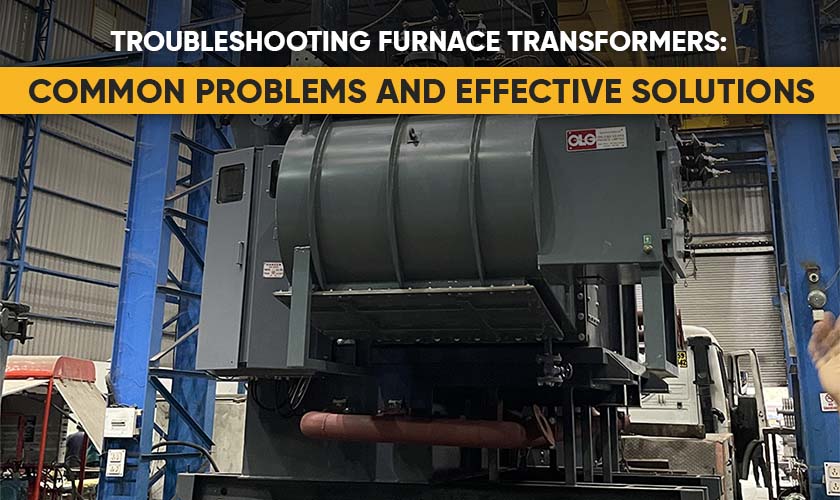Furnace transformers are a small but important component responsible for stepping down the voltage from your home’s electrical system to levels appropriate for your system.
This process ensures that the furnace operates safely and effectively. However, when problems arise with the transformer, it can lead to a cascade of issues. In this blog, we will explain what the transformers are, how they work, and how to troubleshoot these problems.
The Role of the Furnace Transformer
Before we dive into the problems, let's understand the fundamental role of the furnace transformer. In simple terms, a transformer is an electrical device that transfers electrical energy between two or more circuits.
The furnace transformer specifically steps down the voltage from the standard to a lower voltage that the furnace's components can safely handle.
This lower voltage powers various parts of the furnace, such as the control board, thermostat, and gas valve.
Common Problems with Furnace Transformers
Overloading: One of the most prevalent issues with furnace transformers is overloading. This occurs when the transformer is subjected to a higher electrical load than it can handle. Overloading can happen due to various reasons, such as a short circuit in the wiring, a malfunctioning component drawing too much power, or adding new components to the system that exceed the transformer's capacity.
Burnout: Burnout is another common problem, often resulting from prolonged overloading or a sudden power surge. When a transformer burns out, it fails to step down the voltage effectively, leading to malfunctions in the furnace's electrical components.
Wiring Issues: If there are any loose cables or faulty or damaged wires inside your transformer, they can cause short circuits, overloading, and ultimately, transformer failure.
External Power Surges: External power surges, such as those caused by lightning strikes or utility grid fluctuations, can send a surge of electricity through the system, overwhelming the transformer and causing damage.
Age and Wear: Like all mechanical and electrical components, furnace transformers have a lifespan. Over time, they can wear out due to regular use, exposure to heat, and other environmental factors.
Signs of a Faulty Furnace Transformer
Now that we've explored potential problems let's look at some common signs that indicate your furnace transformer might be failing:
Frequent Circuit Breaker Trips:If your furnace's circuit breaker trips frequently, it could be a sign of an overloaded transformer.
Inconsistent Heating:A malfunctioning transformer might cause your furnace to produce inconsistent heat levels or fail to heat your home adequately.
Unresponsive Thermostat:
If your thermostat doesn't seem to be communicating with the furnace, the transformer might be to blame.
Burnt Smell:
A brunt smell coming from the furnace could indicate a transformer issue, especially if there are other signs and symptoms of the same.
Visible Damage:
Sometimes during a visual inspection of your transformer, you can identify the issues with equipment right away. Physical damage to the transformer, like burn marks or melted components, is a clear sign of trouble.
Troubleshooting and Solutions
If you suspect that your furnace transformer is the culprit behind your heating woes, there are steps you can take to troubleshoot the issue:
Check for Tripped Breakers: Start by checking the circuit breakers for your furnace. If they've tripped, reset them and see if the furnace resumes normal operation. However, if the breakers continue to trip, there may be a more significant issue at play.
Inspect Wiring: Turn off the furnace and inspect the wiring, looking for any damages or loose connections. Replace or repair any compromised wiring carefully.
Test the Transformer: Using a multimeter, you can test the transformer to see if it's functioning correctly. If the readings are outside the acceptable range, it's likely time for a replacement.
Professional Inspection: If you're uncomfortable or uncertain about troubleshooting electrical components, it's always best to call a professional HVAC technician. They have the expertise and tools to diagnose and repair furnace transformer issues safely.
Consider Upgrades: If your furnace transformer has reached the end of its lifespan or cannot meet the demands of your heating system, consider upgrading to a higher-capacity transformer. This can prevent future issues and improve the efficiency of your furnace.
Final Thoughts
A furnace transformer may seem insignificant, but its role in keeping your heating system running smoothly cannot be overstated. When problems arise, understanding the signs and potential causes can help you address issues promptly. Whether it's overloading, burnout, or power surges, you must take the necessary steps to maintain the furnace’s functionality. You can always seek the expertise of an HVAC technician to diagnose and resolve the issue immediately. By staying vigilant and addressing the problems promptly you can keep your hesitating system in top condition for years to come.






